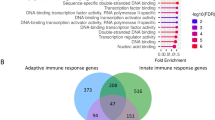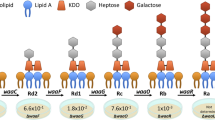Abstract
Only few instances are known of protein folds that tolerate massive sequence variation for the sake of binding diversity. The most extensively characterized is the immunoglobulin fold. We now add to this the C-type lectin (CLec) fold, as found in the major tropism determinant (Mtd), a retroelement-encoded receptor-binding protein of Bordetella bacteriophage. Variation in Mtd, with its ∼1013 possible sequences, enables phage adaptation to Bordetella spp. Mtd is an intertwined, pyramid-shaped trimer, with variable residues organized by its CLec fold into discrete receptor-binding sites. The CLec fold provides a highly static scaffold for combinatorial display of variable residues, probably reflecting a different evolutionary solution for balancing diversity against stability from that in the immunoglobulin fold. Mtd variants are biased toward the receptor pertactin, and there is evidence that the CLec fold is used broadly for sequence variation by related retroelements.
This is a preview of subscription content, access via your institution
Access options
Subscribe to this journal
Receive 12 print issues and online access
$189.00 per year
only $15.75 per issue
Buy this article
- Purchase on Springer Link
- Instant access to full article PDF
Prices may be subject to local taxes which are calculated during checkout





Similar content being viewed by others
References
Liu, M. et al. Reverse transcriptase-mediated tropism switching in Bordetella bacteriophage. Science 295, 2091–2094 (2002).
Liu, M. et al. Genomic and genetic analysis of Bordetella bacteriophages encoding reverse transcriptase-mediated tropism-switching cassettes. J. Bacteriol. 186, 1503–1517 (2004).
Doulatov, S. et al. Tropism switching in Bordetella bacteriophage defines a family of diversity-generating retroelements. Nature 431, 476–481 (2004).
Chothia, C. & Lesk, A.M. Canonical structures for the hypervariable regions of immunoglobulins. J. Mol. Biol. 196, 901–917 (1987).
Davis, M.M. & Bjorkman, P.J. T-cell antigen receptor genes and T-cell recognition. Nature 334, 395–402 (1988).
Uhl, M.A. & Miller, J.F. Integration of multiple domains in a two-component sensor protein: the Bordetella pertussis BvgAS phosphorelay. EMBO J. 15, 1028–1036 (1996).
Akerley, B.J., Cotter, P.A. & Miller, J.F. Ectopic expression of the flagellar regulon alters development of the Bordetella-host interaction. Cell 80, 611–620 (1995).
Cotter, P.A. & Miller, J.F. A mutation in the Bordetella bronchiseptica bvgS gene results in reduced virulence and increased resistance to starvation, and identifies a new class of Bvg-regulated antigens. Mol. Microbiol. 24, 671–685 (1997).
Emsley, P., Charles, I.G., Fairweather, N.F. & Isaacs, N.W. Structure of Bordetella pertussis virulence factor P.69 pertactin. Nature 381, 90–92 (1996).
Hester, G., Kaku, H., Goldstein, I.J. & Wright, C.S. Structure of mannose-specific snowdrop (Galanthus nivalis) lectin is representative of a new plant lectin family. Nat. Struct. Biol. 2, 472–479 (1995).
Sauerborn, M.K., Wright, L.M., Reynolds, C.D., Grossmann, J.G. & Rizkallah, P.J. Insights into carbohydrate recognition by Narcissus pseudonarcissus lectin: the crystal structure at 2 A resolution in complex with alpha1–3 mannobiose. J. Mol. Biol. 290, 185–199 (1999).
Weis, W.I., Kahn, R., Fourme, R., Drickamer, K. & Hendrickson, W.A. Structure of the calcium-dependent lectin domain from a rat mannose-binding protein determined by MAD phasing. Science 254, 1608–1615 (1991).
Holm, L. & Sander, C. Protein structure comparison by alignment of distance matrices. J. Mol. Biol. 233, 123–138 (1993).
Feinberg, H. et al. Structure of a C-type carbohydrate recognition domain from the macrophage mannose receptor. J. Biol. Chem. 275, 21539–21548 (2000).
Batchelor, M. et al. Structural basis for recognition of the translocated intimin receptor (Tir) by intimin from enteropathogenic Escherichia coli. EMBO J. 19, 2452–2464 (2000).
Luo, Y. et al. Crystal structure of enteropathogenic Escherichia coli intimin-receptor complex. Nature 405, 1073–1077 (2000).
Drickamer, K. C-type lectin-like domains. Curr. Opin. Struct. Biol. 9, 585–590 (1999).
Tormo, J., Natarajan, K., Margulies, D.H. & Mariuzza, R.A. Crystal structure of a lectin-like natural killer cell receptor bound to its MHC class I ligand. Nature 402, 623–631 (1999).
Weis, W.I., Drickamer, K. & Hendrickson, W.A. Structure of a C-type mannose-binding protein complexed with an oligosaccharide. Nature 360, 127–134 (1992).
Takano, K., Yamagata, Y. & Yutani, K. A general rule for the relationship between hydrophobic effect and conformational stability of a protein: stability and structure of a series of hydrophobic mutants of human lysozyme. J. Mol. Biol. 280, 749–761 (1998).
Mooi, F.R. et al. Polymorphism in the Bordetella pertussis virulence factors P.69/pertactin and pertussis toxin in The Netherlands: temporal trends and evidence for vaccine-driven evolution. Infect. Immun. 66, 670–675 (1998).
Blum, M.L. et al. A structural motif in the variant surface glycoproteins of Trypanosoma brucei. Nature 362, 603–609 (1993).
Parge, H.E. et al. Structure of the fibre-forming protein pilin at 2.6 A resolution. Nature 378, 32–38 (1995).
Van der Ploeg, L.H. et al. An analysis of cosmid clones of nuclear DNA from Trypanosoma brucei shows that the genes for variant surface glycoproteins are clustered in the genome. Nucleic Acids Res. 10, 5905–5923 (1982).
Pancer, Z. et al. Somatic diversification of variable lymphocyte receptors in the agnathan sea lamprey. Nature 430, 174–180 (2004).
Bellotti, V., Mangione, P. & Merlini, G. Review: immunoglobulin light chain amyloidosis–the archetype of structural and pathogenic variability. J. Struct. Biol. 130, 280–289 (2000).
Stevens, F.J. Four structural risk factors identify most fibril-forming kappa light chains. Amyloid 7, 200–211 (2000).
Pokkuluri, P.R. et al. Increasing protein stability by polar surface residues: domain-wide consequences of interactions within a loop. Biophys. J. 82, 391–398 (2002).
Helms, L.R. & Wetzel, R. Destabilizing loop swaps in the CDRs of an immunoglobulin VL domain. Protein Sci. 4, 2073–2081 (1995).
Emsley, P., McDermott, G., Charles, I.G., Fairweather, N.F. & Isaacs, N.W. Crystallographic characterization of pertactin, a membrane-associated protein from Bordetella pertussis. J. Mol. Biol. 235, 772–773 (1994).
Otwinowski, Z. & Minor, W. Processing of x-ray diffraction data collected in oscillation mode. Methods Enzymol. 276, 307–326 (1997).
Terwilliger, T.C. Multiwavelength anomalous diffraction phasing of macromolecular structures: analysis of MAD data as single isomorphous replacement with anomalous scattering data using the MADMRG Program. Methods Enzymol. 276, 530–537 (1997).
Winn, M.D. An overview of the CCP4 project in protein crystallography: an example of a collaborative project. J. Synchrotron Radiat. 10, 23–25 (2003).
Perrakis, A. wARP: improvement and extension of crystallographic phases by weighted averaging of multiple-refined dummy atomic models. Acta Crystallogr. D Biol. Crystallogr. 53, 448–455 (1997).
Jones, T.A., Zou, J.-Y., Cowan, S.W. & Kjeldgaard, M. Improved methods for building protein models in electron density maps and the location of errors in these models. Acta Crystallogr. A 47, 110–119 (1991).
Wiseman, T., Williston, S., Brandts, J.F. & Lin, L.N. Rapid measurement of binding constants and heats of binding using a new titration calorimeter. Anal. Biochem. 179, 131–137 (1989).
Acknowledgements
This work was supported by a W.M. Keck Distinguished Young Scholars in Medicine Award to P.G., a University of California Discovery Grant to J.F.M. and US National Institutes of Health grants T32GM008326 and F31AI061840 to J.L.M. and F32AI49695 to J.A.L. Discussions with F. Stevens on antibody stability are appreciated, as is help with ITC from S. Bergqvist.
Author information
Authors and Affiliations
Corresponding author
Ethics declarations
Competing interests
The authors declare no competing financial interests.
Supplementary information
Supplementary Fig. 1
Topology diagram of Mtd. (PDF 172 kb)
Supplementary Fig. 2
Mtd-P1 and Prn-E associate in a 3:1 complex (PDF 114 kb)
Supplementary Table 1
Data collection, phasing and refinement statistics for MAD (SeMet) structures (PDF 51 kb)
Supplementary Table 2
Data collection and refinement statistics (molecular replacement) (PDF 47 kb)
Rights and permissions
About this article
Cite this article
McMahon, S., Miller, J., Lawton, J. et al. The C-type lectin fold as an evolutionary solution for massive sequence variation. Nat Struct Mol Biol 12, 886–892 (2005). https://doi.org/10.1038/nsmb992
Received:
Accepted:
Published:
Issue Date:
DOI: https://doi.org/10.1038/nsmb992
This article is cited by
-
Eco-evolutionary significance of domesticated retroelements in microbial genomes
Mobile DNA (2022)
-
Ecology and molecular targets of hypermutation in the global microbiome
Nature Communications (2021)
-
Discovery and characterization of the evolution, variation and functions of diversity-generating retroelements using thousands of genomes and metagenomes
BMC Genomics (2019)
-
Conservation of the C-type lectin fold for accommodating massive sequence variation in archaeal diversity-generating retroelements
BMC Structural Biology (2016)
-
Targeted diversity generation by intraterrestrial archaea and archaeal viruses
Nature Communications (2015)



